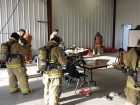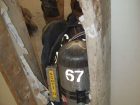
Back to Basics: October 2018
By Mark van der Feyst
Features Fire Ground Training Equipment firefighter SCBAI have been looking at the mayday function of firefighter survival in the past few issues and how important it is to the survivability of each firefighter.
 Students practice donning their SCBA or self-contained breathing apparatus. I have been looking at the mayday function of firefighter survival
Students practice donning their SCBA or self-contained breathing apparatus. I have been looking at the mayday function of firefighter survivalSCBA emergencies is the next chapter of our study. I have laid the foundation for how, when and why you need to call for help, and one of those reasons to call is based upon a malfunction with SCBA, or self-contained breathing apparatus.
This piece of equipment is the single most important and improved upon piece of equipment that firefighters use and need to use.
In the early days of firefighting, we did not have SCBA, but over time we have seen the introduction of SCBA and the advancement of the equipment based upon available technology, line-of-duty deaths, increase in fuel loads and changes in fire dynamics. The SCBA protects the biggest and most-easily-compromised system of our body, the respiratory system. That’s why SCBA is the most important piece of PPE that we must use.
Even though the SCBA has been designed and tested to perform beyond our limitations, it is still a piece of mechanical equipment and it can sustain a malfunction of some type. We have documented evidence of mechanical problems or malfunctions occurring with SCBA. Though not the norm, it does happen.
Having said that, this is the reason why firefighters need to know their SCBA inside and out. When a problem occurs, they will be able to diagnose it quickly and come up with a resolution. The goal of firefighter survival is to get out and to get out quickly, and the SCBA will provide that opportunity if you know how to use it.
This knowledge starts with daily inspection of the SCBA. No matter what brand of SCBA you are using, there is a method to conducting a systematic inspection of it.
There are four components to the SCBA: regulator, cylinder, facepiece and back frame/harness assembly. If all four of these components are checked, then the whole SCBA will be checked. It is imperative that you check the manufacturer recommendations so that you know how a specific SCBA needs to be checked and what to look for.
You should also plan how to put on your SCBA. There are two basic methods to don your SCBA – over your head or the coat method.
Donning the SCBA in the seat-mounted position is only good if you have a seat to place the SCBA on. In the case of firefighter survival, there are no seat-mounted SCBAs inside a building, so you can only rely upon the over-the-head or coat method for donning and doffing your SCBA.
Whichever method you choose, you need to stick with it. You cannot go back and forth between the two – one day donning the SCBA using the coat method and the next day using the over-the-head method. This will just confuse your brain and will not exercise your muscle memory. It is with consistency that we develop muscle memory and, in the case of donning/doffing our SCBA, we need to be consistent with one method.
The other aspect of our SCBA knowledge is with training. You need to train as you play. In the case of SCBA knowledge, it comes with using SCBA. People like to take shortcuts sometimes in training and one shortcut may be not using your SCBA. This may be due to many reasons, but if you have to use it for the real thing, then why not use it all the time so that you become familiar with it and your knowledge of the SCBA increases?
There are four categories of SCBA malfunctions that I’m going to look deeper into over the next couple of issues. They are:
- Reduced profile maneuvers where firefighters need to navigate through a smaller opening to get out and the SCBA may be hindering their ability to do so.
- Entanglements where firefighters find themselves caught or entangled in electrical wires, ceiling grid systems, curtains, or dryer vent pipe wire. The SCBA may be wrapped or caught in the entanglement and prevent progress out
- Equipment failures where the SCBA itself may have parts that fail, such as the straps, buckles, reducing block, or facepiece. When these things happen, there has to be a quick decision made as to what needs to be done to the SCBA so that quick egress can be achieved if possible
- Out-of-air situations where firefighters find there is none left and the SCBA can no longer provide protection.
There is no need to be scared of using the SCBA from what I have described above. The key to surviving any one of these situations is to train for them and become familiar with the SCBA and consistently do the same thing day-in and day-out.
Mark van der Feyst has been a full-time firefighter in Ontario since 1999. He teaches in Canada, the U.S. and India and is lead author of Residential Fire Rescue. Contact Mark at Mark@FireStarTraining.com.
Print this page

